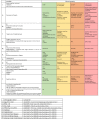An Early Warning Risk Prediction Tool (RECAP-V1) for Patients Diagnosed With COVID-19: Protocol for a Statistical Analysis Plan
- PMID: 34468322
- PMCID: PMC8494068
- DOI: 10.2196/30083
An Early Warning Risk Prediction Tool (RECAP-V1) for Patients Diagnosed With COVID-19: Protocol for a Statistical Analysis Plan
Abstract
Background: Since the start of the COVID-19 pandemic, efforts have been made to develop early warning risk scores to help clinicians decide which patient is likely to deteriorate and require hospitalization. The RECAP (Remote COVID-19 Assessment in Primary Care) study investigates the predictive risk of hospitalization, deterioration, and death of patients with confirmed COVID-19, based on a set of parameters chosen through a Delphi process performed by clinicians. We aim to use rich data collected remotely through the use of electronic data templates integrated in the electronic health systems of several general practices across the United Kingdom to construct accurate predictive models. The models will be based on preexisting conditions and monitoring data of a patient's clinical parameters (eg, blood oxygen saturation) to make reliable predictions as to the patient's risk of hospital admission, deterioration, and death.
Objective: This statistical analysis plan outlines the statistical methods to build the prediction model to be used in the prioritization of patients in the primary care setting. The statistical analysis plan for the RECAP study includes the development and validation of the RECAP-V1 prediction model as a primary outcome. This prediction model will be adapted as a three-category risk score split into red (high risk), amber (medium risk), and green (low risk) for any patient with suspected COVID-19. The model will predict the risk of deterioration and hospitalization.
Methods: After the data have been collected, we will assess the degree of missingness and use a combination of traditional data imputation using multiple imputation by chained equations, as well as more novel machine-learning approaches to impute the missing data for the final analysis. For predictive model development, we will use multiple logistic regression analyses to construct the model. We aim to recruit a minimum of 1317 patients for model development and validation. We will then externally validate the model on an independent dataset of 1400 patients. The model will also be applied for multiple different datasets to assess both its performance in different patient groups and its applicability for different methods of data collection.
Results: As of May 10, 2021, we have recruited 3732 patients. A further 2088 patients have been recruited through the National Health Service Clinical Assessment Service, and approximately 5000 patients have been recruited through the DoctalyHealth platform.
Conclusions: The methodology for the development of the RECAP-V1 prediction model as well as the risk score will provide clinicians with a statistically robust tool to help prioritize COVID-19 patients.
Trial registration: ClinicalTrials.gov NCT04435041; https://clinicaltrials.gov/ct2/show/NCT04435041.
International registered report identifier (irrid): DERR1-10.2196/30083.
Keywords: COVID-19; early warning; modeling; remote assessment; risk score.
©Francesca Fiorentino, Denys Prociuk, Ana Belen Espinosa Gonzalez, Ana Luisa Neves, Laiba Husain, Sonny Christian Ramtale, Emma Mi, Ella Mi, Jack Macartney, Sneha N Anand, Julian Sherlock, Kavitha Saravanakumar, Erik Mayer, Simon de Lusignan, Trisha Greenhalgh, Brendan C Delaney. Originally published in JMIR Research Protocols (https://www.researchprotocols.org), 05.10.2021.
Conflict of interest statement
Conflicts of Interest: Simon de Lusignan is the Director of the Royal College of General Practitioners Research and Surveillance Centre. He has also received a grant through his university from AstraZeneca for vaccine effectiveness and to explore adverse events of interest. All other authors declare no conflicts of interest.
Figures


References
-
- COVID-19 rapid guideline: managing COVID-19. National Institute for Health and Clinical Excellence. 2021. [2021-04-07]. https://www.nice.org.uk/guidance/ng191 .
-
- RCGP clarification on the use of Roth scores in the assessment of patients with potential COVID-19. Royal College of General Practitioners. 2020. [2021-04-07]. https://www.rcgp.org.uk/about-us/news/2020/april/rcgp-clarification-on-t... .
-
- Greenhalgh T. Should the Roth Score be used in the remote assessment of patients with possible COVID-19? The Centre for Excellence-Based Medicine. 2020. [2021-04-07]. https://www.cebm.net/covid-19/roth-score-not-recommended-to-assess-breat...
-
- Wu Z, McGoogan JM. Characteristics of and important lessons from the coronavirus disease 2019 (COVID-19) outbreak in China: summary of a report of 72 314 cases from the Chinese Center for Disease Control and Prevention. JAMA. 2020 Apr 07;323(13):1239–1242. doi: 10.1001/jama.2020.2648.2762130 - DOI - PubMed
-
- Espinosa-Gonzalez A, Neves AL, Fiorentino F, Prociuk D, Husain L, Ramtale SC, Mi E, Mi E, Macartney J, Anand SN, Sherlock J, Saravanakumar K, Mayer E, de Lusignan S, Greenhalgh T, Delaney BC. Predicting risk of hospital admission in patients with suspected COVID-19 in a community setting: protocol for development and validation of a multivariate risk prediction tool. JMIR Res Protoc. 2021 May 25;10(5):e29072. doi: 10.2196/29072. https://www.researchprotocols.org/2021/5/e29072/ v10i5e29072 - DOI - PMC - PubMed
Associated data
Grants and funding
LinkOut - more resources
Full Text Sources
Medical
Research Materials

